Koji is the term for a grain or bean that has been inoculated with Aspergillus Oryzae, a special fungus that has been domesticated for about 9000 years.
White Rice Koji is made by steaming white rice and then allowing spores of Aspergillus Oryzae to germinate and multiply on it.
This process is carefully controlled to ensure conditions are perfect for koji growth, with both temperature and humidity monitored continually. The fungus then converts starch within the rice into a range of enzymes, which go on to create the delicious range of savoury/umami flavours within foods like miso and soy sauce.
Koji can be eaten raw, but is at it’s best when added to other ingredients to create an umami flavour in the food.
Koji does not contain any of the 14 allergens named by the UK food standards agency, and can be used to make allergen free alternatives of popular Japanese foods such as miso (e.g. using fava beans or green lentils), or soya sauce (using fava beans)
Yes, Koji just contains rice and a fungus and is completely vegan.
If you have any more questions about Koji, or how it is used, please leave a question in the comments and we’ll do our best to answer it.
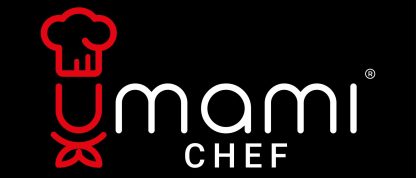






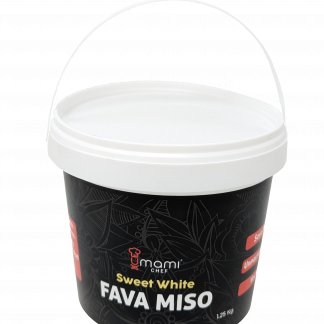

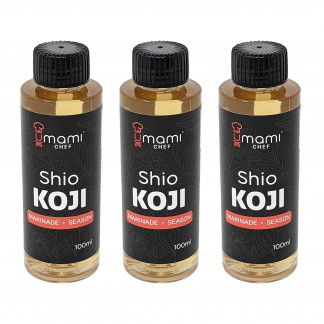
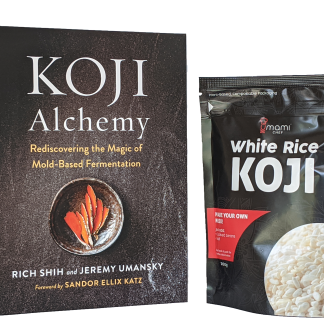
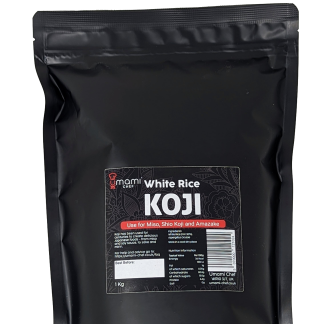


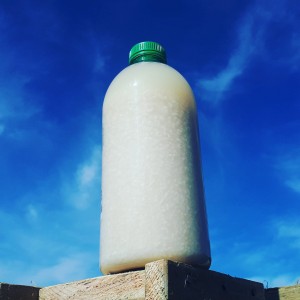

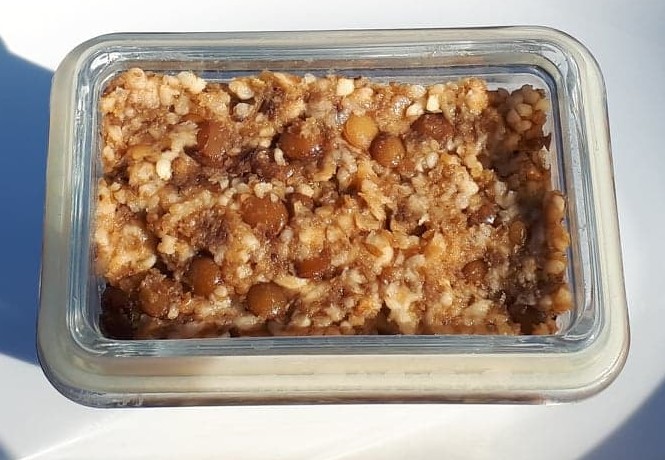
Hi,
Do you make koji yourself, in the UK? Or is it imported?
Thanks
We make all our koji here in the UK – in rural Worcestershire. It’s all handmade in small batches.
Hi, how long is the shelf life? Where should I keep it before opened and after?
Many thanks.
The shelf life is four months from manufacture, so will generally be 3+ months from purchase.
Before opening it can be stored on a shelf/in a cupboard – just as you’d store uncooked rice.
After opening it is very important that it stays dry. I have stored open koji for many several months here, but there is a danger it will go bad if exposed to moisture. If possible, store in an airtight container.
Hi. I wonder if you sell just the fungus (Aspergillus Oryzae)? If so, what’s the price per, say, 15g?
Thank you.
Sorry, due to the agreement we have with the Japanese spore producer we are unable to sell spores – only koji rice.
Hi,
If im making koji water (blending koji and water and sieve it well) is there an easy (or multiply) way to stabelize it? so it would hold in a fridge longer than 5 days?
It will probably be OK in a fridge for a lot longer than 5 days, but I have to remain on the cautious side of things. The easiest way to get it to last longer is to increase the salt content – or you could add some neutral alcohol. You can also freeze it, or even dehydrate it.
Hi! Keen to try, but I’m interested To know what prevents the growth of Bacillus Cereus when producing the rice koji? Steamed rice at room temperature would normally give optimum conditions for that to grow?
Yes, Bacillus Cereus is something that koji growers have to be aware of. The rice is steamed, which kills any Bacillus Cereus present. The steamed rice is then cooled quickly, giving any remaining spores as little time as possible to germinate. The steamed rice also has a very different texture to cooked rice – it is drier (has a much lower aw) which means conditions aren’t favourable for the B cereus. All the conditions are stacked in favour of the koji, which means the B Cereus doesn’t have a chance. Our koji is also lab tested at regular intervals to check our processes, ensuring B cereus isn’t an issue.
If I have a rice allergy or mold allergy should I consume rice koji or koji of any kind?
I do take aspergillus in a digestive tablet with no reaction.
If you have a rice allergy you should not eat rice koji or anything made with rice koji.
I’m afraid I can’t advise on the mold allergy – that depends on the type of allergy you have. There are thousands of different fungi and without testing I couldn’t say whether it would be safe. If you have eaten aspergillus oryzae in the past then it may be fine. But do not eat if you have a rice allergy.
Hi …… Do I get the same nutrition value if consuming Koji Spore in raw form without and cooking or marination involved.
Is it safe to consume Koji Spore in raw form?
Thanks
The nutritional power of koji is obtained by using it to ferment other things. The koji creates a range of nutrients, including all the essential amino acids that the body needs, when used to make things like miso or amazake. If you’re after as much benefit as possible from the koji then do not cook the miso after making it – eat it raw.
Rice koji is safe to eat raw, but it would be like eating raw rice, so I wouldn’t recommend it.
How can I rehidrate the dry koji rice to riproduce the usual quantity of umidity?
It’s not necessary to rehydrate the dry koji rice before use, but if you want to then just soak in water for a few hours, then strain the excess water away.
How much water to soak ?
For most applications there is no need to pre soak the koji before use. If you’re using a recipe that uses fresh koji you can add 30% extra water for the weight of dried koji you add – 60g for every 200g dried koji. If you want to presoak, just put the dried rice koji in cold water overnight and then drain off any excess water which hasn’t been absorbed.
Hi there, I was wondering if rice koji is safe to eat raw, would it apply to all koji products like barley koji, soybean koji? Given that it would go through the same process: soaked -> steamed -> inoculated -> maintenance. I am attempting to use barley koji as an outer shell/component for a dessert.
Yes, fresh barley koji is safe to eat raw.
Thank you!
Hello,
I bought koji rice from you and it says that it is best before Dec.2021 so it is not a really long self life. I am trying to make chickpea miso as I am not allowed to eat soy due to breast cancer op. 2 years ago. Which recipe should I follow, the on on the package? I live in Hungary and I cannot buy chickpea miso here so I have to try to make it. I also loved soysauce a lot. Can I make it using chickpea and koji?
Yes, the shelf life is only 4 months from manufacture – generally 3+ months from purchase. This is mainly because of the sustainable packaging used – it is home compostable and starts to break after 6 months. The koji itself will be fine to use for a while after that, but will become less powerful over time.
Yes, you can use the koji to make chickpea miso – just follow the recipe on the packet and use chickpeas instead of soy. You can use exactly the same weight of chickpeas as it suggests for soy beans. Enjoy making your miso!
Hey Chef! I’m following Nomas koji recipe and I’m unsure if I need to put a damp towel back on for the second 24hrs. It says to furrow the grains into 3 rows but doesn’t say if the towel goes back on.
Thanks!
That depends on whether you have an environment where the humidity is precisely controlled. If you don’t, then add the towel back on. If the humidity is controlled then there is no need. Good luck with your koji!
I would like to koji spores for use in coffee fermentation. Do you sell koji spores as ingredients for food processing in the UK
Sorry, We do not sell the spores, only koji rice, on which the spores already grown.
Hi, I found a recipe for making Japanese soy sauce, requiring sprinkling koi mould over cooked and mostly cooled soya beans and then leaving them to dry for about a week. The beans were then added to sterilised jars with a salt brine and fermented with stirring over the course of a year. If I were to stir in Koji rice and follow the same principle, would this still ferment in the same way please?
Hi Julie,
Without seeing the recipe it is hard to know why you’d sprinkle koji over cooked beans and then leave for 5 days – that seems like a long time. If you’re able to forward it to me: [email protected] I can take a look and see what’s going on. The second step seems much better. If you add the koji to the salt brine and cooked beans and then stir regularly you will get a delicious soy sauce after a year.
Is there any recomendation on the maximum quantity you can eat, for fresh koji? Is is it possible you can feel sick or anything like that. Just in terms of food safety. I mean, saying if I buy certificed spores, or certified rice koji. thanks for clearing.
Koji is safe to eat – you can eat as much as you like!
Can you improve a salt brine by adding Shio Koji or the Koji would die ?
Yes, you can! It works 10x better than a salt brine! It’s called shio koji – you ferment the koji in brine for 7 – 10 days. More details about how it works here: https://umami-chef.co.uk/shio-koji
Why not produce 2 types of koji rice, like one with aspergillus oryzae strain that produces more protease enzymes and other with aspergillus oryzae that produces more amylase enzymes?
This way people would buy the one better for sweet applications, like amazake, or better for umami & protein application like shiokoji or shoyu.
Hi Alberto, Yes that is something we’ve considered and may do in the future. At the moment we’ve specifically picked an aspergillus strain which is balanced for both protease and amylase – so does a great job with both sweet and savoury applications. The only difference with a specialist koji would be that it would work a bit faster – something most people won’t notice in small scale recipes.
Hello
I’ve seen a few recipes that use Koji powder to marinate steak. Would I just grind this to get Koji powder?
Thank you
Yes, just grind the white rice koji to make the powder.
Do you ship to Australia?
Sorry, no we don’t
i have koji spores – can i mix this with rice flower and use it on shrimp fish etc ( its not koji grind ) its the spore direct with flower rice mix
– sprinkle to food direct let it sit for one day and use it
Sorry, I am not experienced in this. Growing koji on seafood is a very advanced thing to do and requires lots of safety knowledge. It is possible, but I advise against it until you’ve mastered growing on vegetables first.
Hi, I am going to make a sourdough miso, I have your White rice Koji, can you please help me, do I need to cook and then ferment the White rice Koji before I can make the miso, or is this rice pre cooked and then dried, making it ready to mix in with the other ingredients.
Many thanks for your help.
Hi Susie, Thank you for buying our koji! Please do not cook the koji – you’ll kill all the enzymes you need to make the miso. The koji is ready to use – just mix it with your sourdough and salt. You will probably need to add a bit of water to get it to the right consistency. When blended with the bread, salt and koji you should be able to form balls which do not ooze liquid when you squeeze them or be so dry they fall apart. Remember to include the weight of the water in your total weight when calculating how much salt to add. Feel free to add more questions as you have them. Good luck!